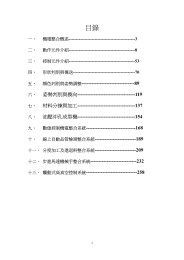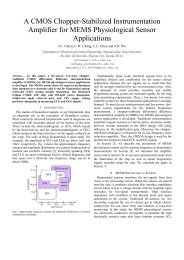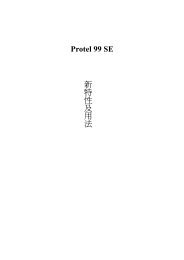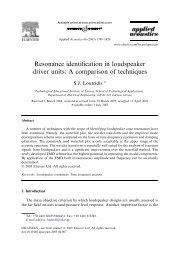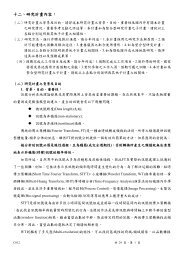IRIS RECOGNITION BASED ON HILBERT–HUANG TRANSFORM 1 ...
IRIS RECOGNITION BASED ON HILBERT–HUANG TRANSFORM 1 ...
IRIS RECOGNITION BASED ON HILBERT–HUANG TRANSFORM 1 ...
Create successful ePaper yourself
Turn your PDF publications into a flip-book with our unique Google optimized e-Paper software.
Iris Recognition Based on Hilbert–Huang Transform 627<br />
By the EMD algorithm, any signal x(t) can be decomposed into finite IMFs,<br />
cj(t)(j =1, 2,...,n), and a residue r(t), where n is the number of IMFs, i.e.<br />
x(t) =<br />
n<br />
cj(t)+r(t). (1)<br />
j=1<br />
Having obtained the IMFs by EMD, we can apply the Hilbert transform to each<br />
IMF, cj(t), to produce its analytic signal zj(t) =cj(t) +iH[cj(t)] = aj(t)e iθj(t) .<br />
Therefore, x(t) can also be expressed as<br />
x(t) =Re<br />
n<br />
aj(t)e iθj (t) + r(t). (2)<br />
j=1<br />
Equation (2) enables us to represent the amplitude and the instantaneous frequency<br />
as functions of time in a three-dimensional plot, in which the amplitude is contoured<br />
on the time–frequency plane. The time–frequency distribution of amplitude<br />
is designated as the Hilbert spectrum, denoted by H(f,t) whichgivesatime–<br />
frequency–amplitude distribution of a signal x(t). HHT brings sharp localizations<br />
both in frequency and time domains, so it is very effective for analyzing nonlinear<br />
and nonstationary data.<br />
With the Hilbert spectrum defined, the Hilbert marginal spectrum can be<br />
defined as<br />
h(f) =<br />
T<br />
0<br />
H(f,t)dt. (3)<br />
The Hilbert marginal spectrum offers a measure of total amplitude (or energy)<br />
contribution from each frequency component.<br />
3.2. Main frequency and main frequency center<br />
It is found that the Hilbert marginal spectrum h(f) has some properties, which can<br />
be used to extract features for iris recognition. Specifically, the main frequency center<br />
of the Hilbert marginal spectrum can be served as a feature to identify different<br />
irises. The “main frequency” and “main frequency center” concepts proposed by us<br />
have been clear described and discussed in our previous works. 26,27 We have shown<br />
that the main frequency center can characterize the approximate period very well.<br />
Here, we only review the definitions of main frequency, main frequency center and<br />
other related concepts as follows.<br />
Definition 1 (Main frequency). Let x(t) be an arbitrary time series and h(f)<br />
be its Hilbert marginal spectrum, then fm is called as the main frequency of x(t), if<br />
h(fm) ≥ h(f), ∀f.<br />
Definition 2 (Average Hilbert marginal spectrum of signal series). Let<br />
X = {xj(t)|j =1, 2,...,N}, whereeachxj(t) isatimeseries,andhj(f) bethe



